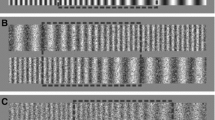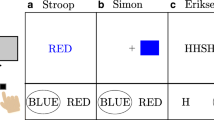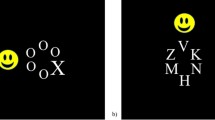Abstract
Under free-viewing conditions, the leftward stimulus features are frequently overestimated (pseudoneglect). This asymmetry could reflect the operation of: (a) spatial attention mechanisms in the right hemisphere (RH) or, (b) stimulus-specific activation. To test these propositions, we attempted to induce a stimulus-specific dissociation between the hemispheres under free-viewing conditions. In two experiments (n=23, n=22) dextrals carried out two tasks. The ‘grayscales’ task required luminance judgments between two mirror-reversed luminance gradients. The flicker task required temporal frequency judgments between two mirror-reversed temporal gradients. The grayscales and flicker tasks suited the processing styles of the right and left hemispheres, respectively. For both experiments, a strong leftward bias was observed for the grayscales task, which could be the result of both of the mechanisms outlined above. In Experiment 1, there was a rightward bias for the flicker task—but only for participants with longer reaction times. In Experiment 2, where all responses were delayed, a rightward bias was found for the flicker task for shorter stimuli. The data demonstrate that stimulus-specific dissociations can be induced under free-viewing conditions. However, the fact that the rightward bias was: (a) weaker than the leftward bias and, (b) reduced by increases in length, demonstrates that RH spatial attention mechanisms are also important.






Similar content being viewed by others
References
Bedson E, Turnbull OH (2002) Hemispheric asymmetry for global and local processing: language is less important than one might think. Brain Cognit 48:272–277
Ben-Hamed S, Duhamel JR, Bremmer F, Graf W (2001) Representation of the visual field in the lateral intraparietal area of macaque monkeys: a quantitative receptive field analysis. Exp Brain Res 140:127–144
Bisiach E, Nichelli P, Spinnler H (1976) Hemispheric functional asymmetry in visual discriminability between univariate stimuli: an analysis of sensitivity and response criterion. Neuropsychologia 14:335–342
Boles DB (2005) A large-sample study of sex differences in functional cerebral lateralization. J Clin Exp Neuropsychol 27:759–768
Bowers D, Heilman KM (1980) Pseudoneglect: effects of hemispace on a tactile line bisection task. Neuropsychologia 18:491–498
Brainard DH (1997) The psychophysics toolbox. Spat Vis 10:433–436
Chokron S, Imbert M (1993) Influence of reading habits on line bisection. Cognit Brain Res 1:219–222
Fink GR, Marshall JC, Shah NJ, Weiss PH, Halligan PW, Grosse-Ruyken M, Ziemons K, Zilles K, Freund HJ (2000) Line bisection judgements implicate right parietal cortex and cerebellum as assessed by fMRI. Neurology 54:1324–1331
Foxe JJ, McCourt ME, Javitt DC (2003) Parietal control of visuospatial attention: line bisection judgments evaluated with high-density electrical mapping and source analysis. NeuroImage 19:710–726
Guseva MV, Zaltsman AG, Meerson YA, Noshchenko VS (1987) Features used for discrimination of textural patterns. Hum Physiol 13:335–340
Hausmann M, Ergun G, Yazgan Y, Güntürkün O (2002) Sex differences in line bisection as a function of hand. Neuropsychologia 40:235–240
Heilman KM, Bowers D, Valenstein E, Watson RT (1987) Hemispace and hemispatial neglect. In: Jeannerod M (ed) Neurophysiological and neuropsychological aspects of spatial neglect. Elsevier, Amsterdam, pp 115–150
Hiscock M, Israelian M, Inch R, Jacek C, Hiscock-Kalil C (1995) Is there a sex difference in human laterality? II. An exhaustive survey of visual laterality studies from six neuropsychology journals. J Clin Exp Neuropsychol 17:590–610
Jewell G, McCourt ME (2000) Pseudoneglect: a review and meta-analysis of performance factors in line bisection tasks. Neuropsychologia 38:93–110
Kaushall P (1975) Functional asymmetries of the human visual asymmetries as revealed by binocular rivalry and binocular brightness matching. Am J Optom Physiol Opt 52:509–520
Kimura D (1966) Dual function asymmetry of the brain in visual perception. Neuropsychologia 4:275–285
Kinsbourne M (1970) The cerebral basis of lateral asymmetries in attention. Acta Psychol 33:193–201
Lindell AK, Nicholls MER, Castles AE (2002) The effect of word length on hemispheric word recognition: evidence from unilateral and bilateral-redundant presentations. Brain Cognit 48:447–452
Luh KE, Rueckert LM, Levy J (1991) Perceptual asymmetries for free viewing of several types of chimeric stimuli. Brain Cognit 16:83–103
McCourt ME (2001) Performance consistency of normal observers in forced-choice tachistoscopic visual line bisection. Neuropsychologia 39:1065–1076
McCourt ME, Jewell G (1999) Visuospatial attention in line bisection: stimulus modulation of pseudoneglect. Neuropsychologia 37:843–855
Mecacci L (1993) On spatial frequencies and cerepral hemispheres: some remarks from electrophysiological and neuropsychological point of view. Brain Cognit 22:199–212
Nicholls MER (1994) Hemispheric asymmetries for temporal resolution: a signal detection analysis of threshold and bias. Q J Exp Psychol 47a:291–310
Nicholls MER (1996) Evidence and implications of a temporal processing dichotomy between the hemispheres. Laterality 1:97–137
Nicholls MER, Bradshaw JL, Mattingley JB (1999) Free-viewing perceptual asymmetries for the judgement of shade, numerosity and size. Neuropsychologia 37:307–314
Nicholls MER, Hughes G, Mattingley JB, Bradshaw JL (2004) Are object and space-based attentional biases both important to free-viewing perceptual asymmetries? Exp Brain Res 154:513–520
Nicholls MER, Smith A, Mattingley JB, Bradshaw JL (2005) The effect of body and environment-centred coordinates on free-viewing perceptual asymmetries for vertical and horizontal stimuli. Cortex (in press)
Oldfield RC (1971) The assessment and analysis of handedness: the Edinburgh inventory. Neuropsychologia 9:97–113
Orr CA, Nicholls MER (2005) The nature and contribution of space- and object-based attentional biases to free-viewing perceptual asymmetries. Exp Brain Res 162:384–393
Pelli DG (1997) The videotoolbox software for visual psychophysics: transforming numbers into movies. Spat Vis 10:437–442
Pelli DG, Zhang L (1991) Accurate control of contrast on microcomputer displays. Vis Res 31:1337–135
Rebai M, Mecacci L, Bagot J, Bonnet C (1986) Hemispheric asymmetries in the visual evoked potentials to temporal frequency: preliminary evidence. Perception 15:589–594
Spiers PA, Schomer DL, Blume HW, Kleefiled J, O’Reilly G, Weintraub S, Osborne P, Mesulam MM (1990) Visual neglect during intracarotid amobarbital testing. Neurology 40:1600–1606
Spinelli D, Mecacci L (1990) Contrast and hemispheric asymmetry: an electrophysiological investigation. Intern J Neurosci 50:113–119
Van Strien JW, Bouma A (1990) Selective activation effects of concurrent verbal and spatial memory loads in left-handed and right-handed adults. Brain Cognit 14:81–91
Yovel G, Levy J, Grabowecky M, Paller KA (2003) Neural correlates of the left-visual-field superiority in face perception appear at multiple stages of face processing. J Cognit Neurosci 15:462–474
Acknowledgements
This research was supported by a grant from the Japan Society for the Promotion of Science to the first author.
Author information
Authors and Affiliations
Corresponding author
Rights and permissions
About this article
Cite this article
Okubo, M., Nicholls, M.E.R. A stimulus-dependent dissociation between the cerebral hemispheres under free-viewing conditions. Exp Brain Res 172, 49–56 (2006). https://doi.org/10.1007/s00221-005-0303-8
Received:
Accepted:
Published:
Issue Date:
DOI: https://doi.org/10.1007/s00221-005-0303-8




